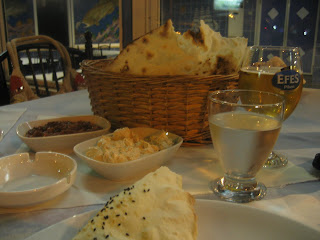
And now it's time for a dish that I am aware may elicit the ire of my dear Italian and Mexican friends. My apologies, in advance!
It was another cupboard-cleaning affair of a dinner. These tend to happen during that stretch between Thanksgiving and Christmas, when both my budget and my patience for yet more food shopping are stretched thin. I embrace these impromptu meals, rummaging through the crisper to see what is on the verge of going soft and concave and winding forearms deep into the dark depths, precariously between bottles, to snatch up whatever jars and packets of goodness-knows-what that have been knocking around for far too long.
A chicken breast. Fresh tagliatelle. Chipotles in adobo. Whipping cream.
Go.
Go.
Chipotle Chicken Tagliatelle
Approx. 300-400g fresh tagliatelle pasta
1/2 medium white onion, sliced
1 tsp. brown sugar
4 Tbs. virgin olive oil
1 boneless, skinless chicken breast
2 cloves garlic, minced
6-8 cherry tomatoes, washed, stemmed and halved
Zest of 1/2 a lemon
4 dashes Worcestershire sauce
2 chipotle peppers in adobo, roughly chopped
6 oz chicken broth
4 oz heavy whipping cream (or single cream, or half-and-half, if feeling more virtuous)
Flat-leaf Italian parsley, to garnish (optional)
Salt and ground black pepper
In an oven-proof skillet, soften the onion on a medium heat in 1 Tbs. of olive oil and season with salt and pepper. When the onions have begun to soften and go a bit translucent, add the brown sugar and caramelise the onion. Once the onions have caramelised (sugar has dissolved, onions are soft and sticky), remove from the pan and set aside.
Chop the chipotle peppers and rub them all over the chicken, using a bit of the jarred adobo as well. Return the skillet to the hob and, in 3 Tbs. of olive oil, brown the chicken breast. Once the chicken is browned (1-2 minutes each side), add the onions back into the pan, along with the garlic, cherry tomatoes, Worcester sauce, and lemon zest. Stir and saute for a minute or so. Then, add just enough chicken stock to deglaze the pan. Cover the skillet with foil and put in a 220-degree C oven for 10-15 minutes, or until the chicken breast is cooked through and its juices run clear when pierced.
Remove the chicken from the pan and slice on a cutting board. Return the skillet to the hob on a low heat and add the cream, stirring continuously with a whisk until a thickened sauce is formed. As the sauce thickens and reduces on a very low simmer, cook the fresh pasta in salted boiling water.
Strain the pasta, reserving a few ounces of the pasta water, and add to sauce. Add a bit of the pasta water if sauce is thicker than desired. Stir through thoroughly and plate pasta, topped with sliced chicken and parsley.
While you're at it, if you happen to have some dulce de lechce cream to get rid of, a little parfait of dark chocolate digestives, chocolate chips, and hazelnuts makes a lovely dessert (though I wouldn't recommend following up the pasta with this straight away!).






















































